Unit 9 What does he look like单元复习课件(词组+句型+知识点+语法+写作指导+易错考点)
文档属性
| 名称 | Unit 9 What does he look like单元复习课件(词组+句型+知识点+语法+写作指导+易错考点) | 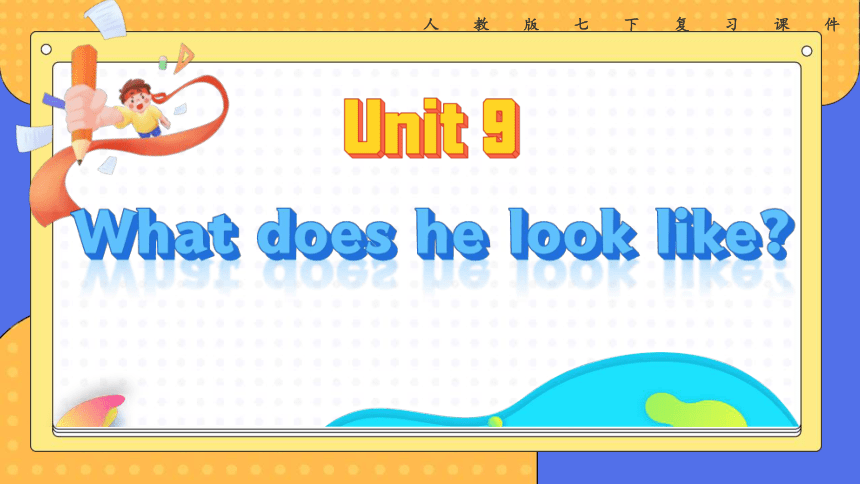 | |
| 格式 | pptx | ||
| 文件大小 | 48.7MB | ||
| 资源类型 | 试卷 | ||
| 版本资源 | 人教新目标(Go for it)版 | ||
| 科目 | 英语 | ||
| 更新时间 | 2024-05-27 15:49:58 | ||
图片预览

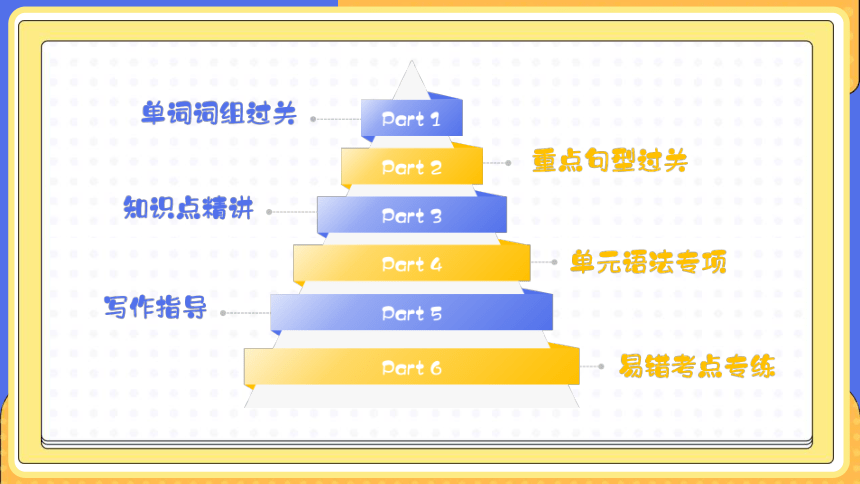
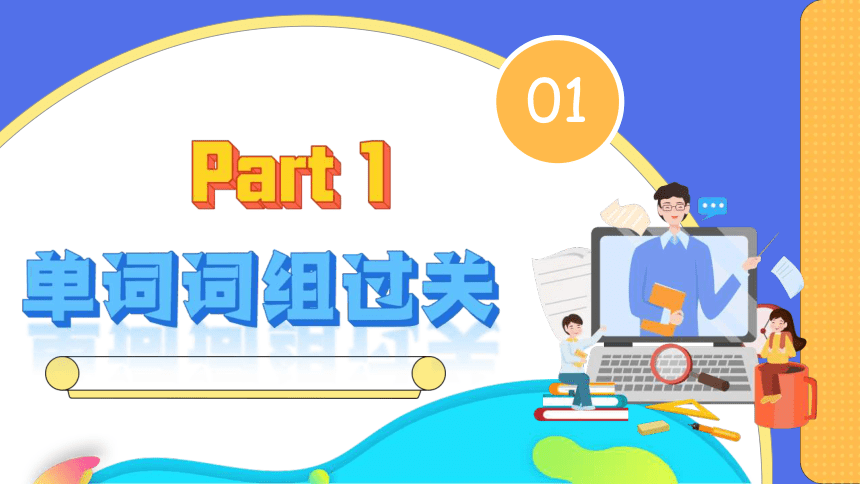
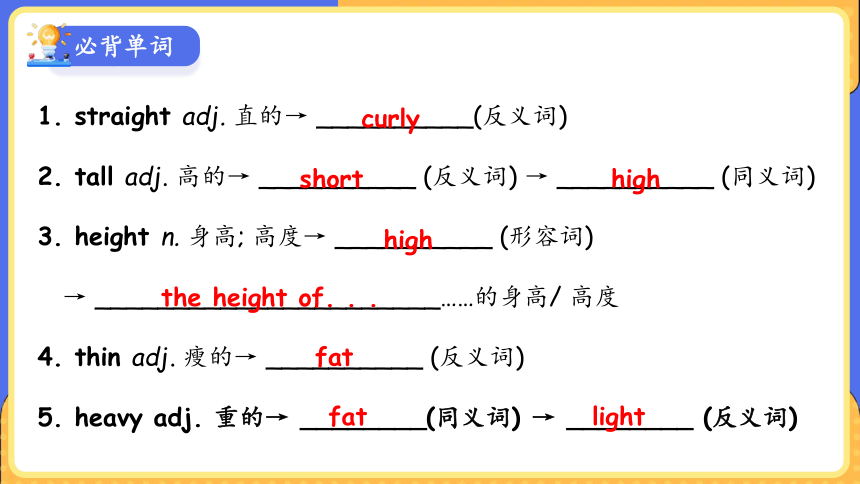
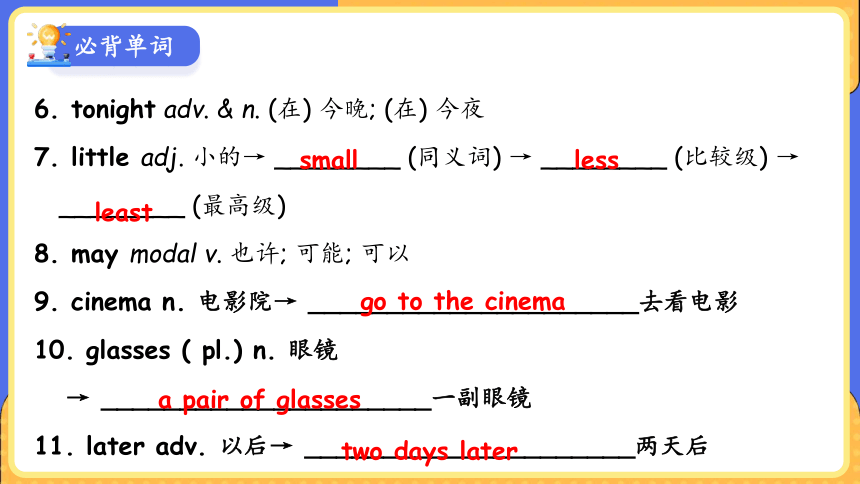
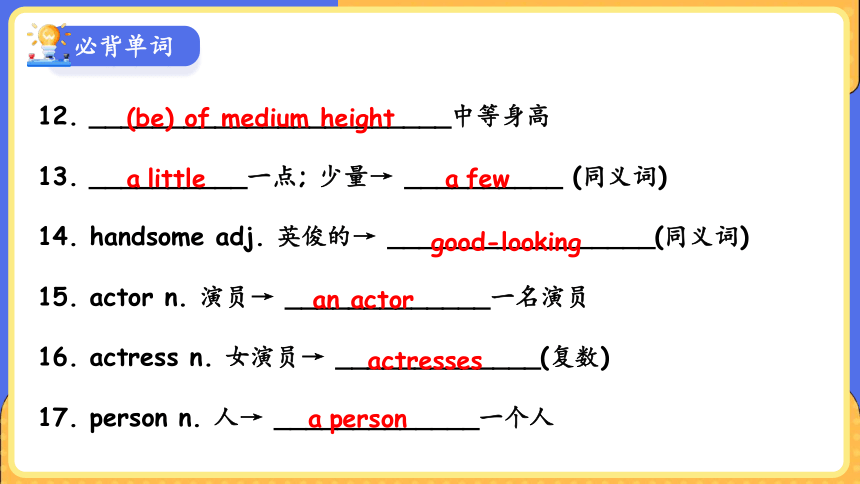


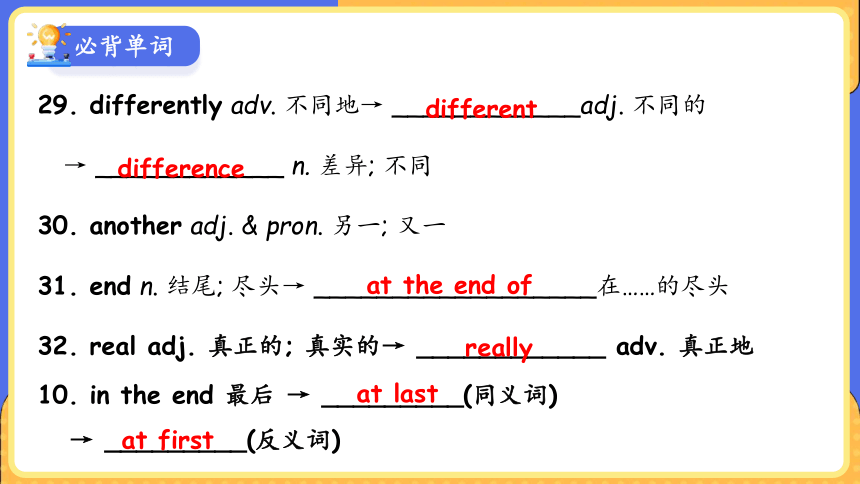
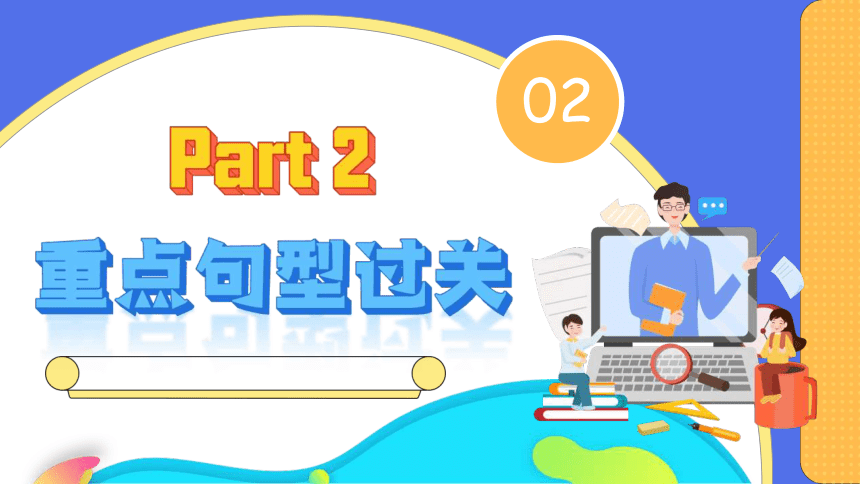
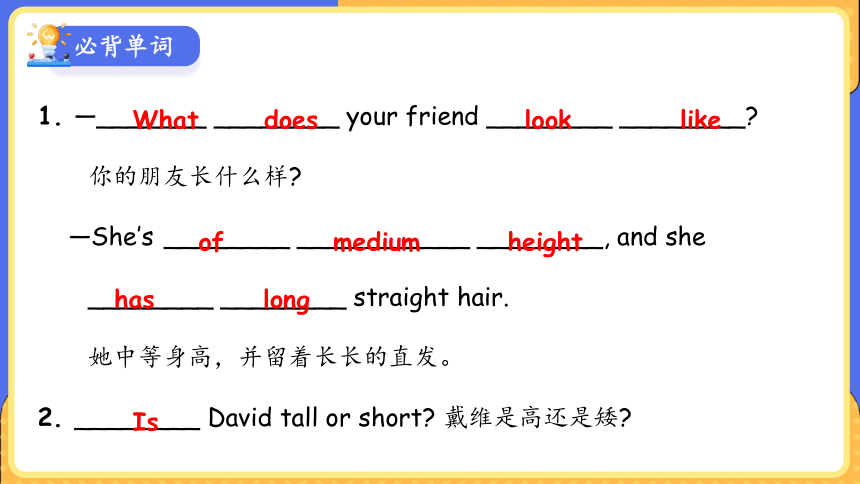
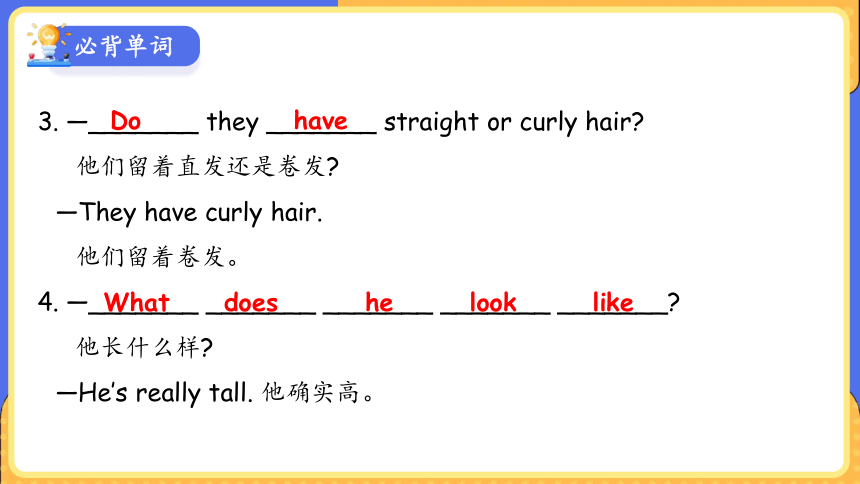
文档简介
(共148张PPT)
人教版七下复习课件
01
必背单词
1. straight adj. 直的→ __________(反义词)
2. tall adj. 高的→ __________ (反义词) → __________ (同义词)
3. height n. 身高; 高度→ __________ (形容词)
→ ______________________……的身高/ 高度
4. thin adj. 瘦的→ __________ (反义词)
5. heavy adj. 重的→ ________(同义词) → ________ (反义词)
curly
short
high
high
the height of. . .
fat
fat
light
必背单词
6. tonight adv. & n. (在) 今晚; (在) 今夜
7. little adj. 小的→ ________ (同义词) → ________ (比较级) → ________ (最高级)
8. may modal v. 也许; 可能; 可以
9. cinema n. 电影院→ _____________________去看电影
10. glasses ( pl.) n. 眼镜
→ _____________________一副眼镜
11. later adv. 以后→ _____________________两天后
small
less
least
go to the cinema
a pair of glasses
two days later
必背单词
12. _______________________中等身高
13. __________一点; 少量→ __________ (同义词)
14. handsome adj. 英俊的→ _________________(同义词)
15. actor n. 演员→ _____________一名演员
16. actress n. 女演员→ _____________(复数)
17. person n. 人→ _____________一个人
(be) of medium height
a little
a few
good-looking
a person
an actor
actresses
必背单词
18. nose n. 鼻子→ ____________ 大鼻子
19. mouth n. 嘴→ ____________ 大嘴
20. round adj. 圆形的→ ________ (到处; 在附近)
21. face n. 脸→ ____________ 圆脸
22. eye n. 眼睛→ ________ (复数)
23. singer n. 歌手→ ________ v. 唱; 演唱
big nose
big mouth
around
round face
eyes
sing
必背单词
24. artist n. 艺术家→ ___________一名艺术家→ ________n. 艺术
25. put v. 放→ ______ (过去式) → ________ (动词的-ing形式)
26. each adj. & pron. 每个; 各自→ ______________彼此; 互相
27. way n. 方式; 路线→ _____________________用这种方法
28. describe v. 描述
→ __________________________ 向某人描述某人/ 某物
an artist
art
put
putting
each other
in this way
describe sb. /sth. to sb.
必背单词
29. differently adv. 不同地→ ____________adj. 不同的
→ ____________ n. 差异; 不同
30. another adj. & pron. 另一; 又一
31. end n. 结尾; 尽头→ __________________在……的尽头
32. real adj. 真正的; 真实的→ ____________ adv. 真正地
10. in the end 最后 → _________(同义词)
→ _________(反义词)
different
difference
at the end of
really
at first
at last
02
必背单词
1. —_______ ________ your friend ________ ________
你的朋友长什么样
—She’s ________ ___________ ________, and she ________ ________ straight hair.
她中等身高,并留着长长的直发。
2. ________ David tall or short 戴维是高还是矮
What does look like
of medium height
has long
Is
必背单词
3. —_______ they _______ straight or curly hair
他们留着直发还是卷发
—They have curly hair.
他们留着卷发。
4. —_______ _______ _______ _______ _______
他长什么样
—He’s really tall. 他确实高。
Do have
What does he look like
必背单词
5. He has ________ ________ ________ ________.
他有一头短而卷曲的棕色头发。
6._________ _________ _________, he is very tall and handsome.
首先,他非常高并非常帅。
short curly brown hair
First of all
03
知识点1:straight /stre t/ adj. 直的
考向:常用于修饰line, hair 等名词, 其反义词是curly, 意为“卷曲的”。
e.g. My friend Cathy has straight hair.
= My friend Cathy’s hair is straight.
我的朋友凯西留着直发。
知识点1:straight /stre t/ adj. 直的
拓展:straight 还可用作副词,意为“笔直地;直接;径直;立即”。
e.g. I’m going straight to bed when I get home.
我打算一到家就直接上床睡觉。
典型例题
The little boy is drawing a ___________(直的)
line on the paper.
straight
知识点2:tall/t l/ adj. 高的
考向:tall常指人、动物、树、建筑物等的“高”,既可作表语也可作定语。其反义词为short。
e.g. The volleyball player is a tall girl.
那位排球运动员是个高个子女孩。
He lives in a tall building.
他住在一幢高楼里。
指人个子高。
表示物体高度高。
知识点2:tall/t l/ adj. 高的
拓展:tall 还可以和表示度量的名词构成短语, 短语中的tall 要置于表示度量的名词之后。
e.g. This tree is five meters tall.
这棵树有5 米高。
经典例题:The boy is only 10 years old, but he is very ____________(高).
tall
知识点3:height /ha t/ n. 身高;高度
考向:其形容词是high“高的”。询问某人的身高或某物的高度是多
少时, 常用“What’s the height of ... ” 或“What’s one’s height ”,相当于“How high/tall is ... ”。
e.g. My aunt is of medium height. 我姑姑中等身高。
What’s the height of that wall = What’s that wall’s height
= How high/tall is that wall 那堵墙有多高?
知识点3:height /ha t/ n. 身高;高度
拓展: height 可与介词in 连用, 常用于描述某人或某物高度的句子中,其结构为“Sb./Sth. + be + 数词+ meter(s)/foot (feet) in height.”。此时,in height 相当于形容词tall或high。
e.g. He is two meters in height.
= He is two meters tall.
他身高两米。
height 的常见搭配:
① the height of... ……的高度
② (be) of medium height
中等身高
③ in height 在高度上
典型例题
—What’s your brother’s _______
—It’s about 1. 75 meters. He’s the tallest in his class.
A. age B. address
C. weight D. height
知识点4:heavy/hevi/ adj. 重的
用法 示例
修饰人, 意为“重的; 胖的”。同义词fat。 His sister is a little heavy.
他姐姐有点胖。
修饰物, 意为“沉的; 重的”, 反义词light(轻的) 。 The box is too heavy.
这个箱子太重了。
知识点4:heavy/hevi/ adj. 重的
拓展:heavy 还可以表示雨或雪大,意为“大(量)的;猛烈的”;也可用于形容交通拥堵。副词形式为heavily。
e.g. What a heavy rain! 好大的雨啊!
To avoid heavy traffic, please get up and set out early.
为了避免交通拥挤,请早点起床出发。
典型例题
—Look! It’s raining ____.
—That’s right. The rain is too ____ for us to go shopping.
A. heavily; heavy B. heavily; heavily
C. heavy; heavy D. heavy; heavily
知识点5:heavy/hevi/ adj. 重的
考向: What + do/does +主语+ look like 某人长什么样?
e.g. —What does your mother look like 你妈妈长什么样?
—She’s beautiful. She is of medium height and has short hair.
她很漂亮。她中等身高并留着短发。
知识点5:heavy/hevi/ adj. 重的
What+do/does+ 主语+look like ?的答语主要有以下三种:
主语+be+ 形容词(表示外貌特征的形容词).
主语+ be of + ...height/build(指身高/身材).
主语+ have/has + 名词(名词前可有多个形容词修饰).
知识点5:heavy/hevi/ adj. 重的
拓展:What’s sb. like 意为“某人怎么样?”,侧重于询问人的性格或品质,也可用来询问人的外貌。
e.g. —What is he like
他是个怎样的人?
—He is friendly.
他很友好。
易错点
The girl looks like her mother.
这个女孩长得像她妈妈。(外貌)
The girl is like her mother.
这个女孩像她妈妈。(性格+外貌)
典型例题
—________
—She is a pretty girl with big bright eyes and long straight hair.
A. How is May B. What does May look like
C. Which one is May D. Who is like May
【点拨】用语境判定法。由答语可知,问句是询问某人的外貌。What does May look like 意为“May 长什么样”,符合语境。
知识点7:现在进行时表将来
考向:表示位移的动词, 如arrive, come, leave, go, start, fly 等,常用现在进行时表将来。主要表示按计划或安排将要发生的动作。
e.g. I’m meeting you after class.
我下课后将和你见面。
拓展:be doing 的用法
be doing 表达的时态 时间状语 例句
表示动作 正在进行 now 等 Ben is having dinner now.
本现在正在吃晚饭。
表示动作 将要发生 tomorrow, next week, soon 等 Are you going to Beijing tomorrow
你明天要去北京吗?
知识点8:may /me / modal v. 也许;可能;可以
考向:may 是情态动词,表示推测,意为“可能,也许”,后面接动词原形。may do sth. 意为“可能做某事”。
e.g. Jack may know the meaning of “the Belt and Road”.
杰克可能知道“一带一路”的意思。
知识点 8:may /me / modal v. 也许;可能;可以
拓展:may 还可表示允许或征求对方许可,意为“可以”。
e.g. May I borrow your pen I can’t find mine.
我可以借用你的钢笔吗?我找不到我的了。
辨析: may be 与maybe
may be 结构为: 情态动词+be动词。在句中作谓语, 置于主语后面。 e. g. That girl standing under a tree may be a student. 站在树下的那个女孩儿可能是一名学生。
maybe 作副词, 意为“或许, 也许, 可能”。在句中作状语。 e. g. Maybe you could move the chair.
也许你可以挪动一下那把椅子。
巧记maybe 与may be:
合并作状语,分开作谓语。
舍maybe 意犹在,
丢may be 不成句。
典型例题
I _______ be late, so don’t wait for me to start the meeting.
A. mustn’t B. needn’t
C. need D. may
典型例题
That boy with glasses ______ Tom, but I’m not sure.
A. maybe B. may be
C. must D. may
知识点8:a little 一点; 少量
考向①:相当于a bit,修饰形容词或副词,在句中作状语。
e.g. My grandma thinks paying through WeChat a little amazing. 我奶奶认为微信支付有点令人惊奇。
考向②:修饰不可数名词,在句中作定语。
e.g. There is a little milk in the bottle. 瓶子里有一点儿牛奶。
考向③:还可用作代词,意为“一点;少量”。
e.g. —Is there any meat in the fridge 冰箱里有肉吗?
—Yes, a little. 是的,有一点。
辨析: a little, little, a few与few
a little “一点; 少量”, 表示肯定含义 修饰 不可数 名词 There is a little rice in your bowl.
你的碗里有一点儿米饭。
little “几乎没有”, 表示否定含义 There is little water in the cup. 杯子里几乎没有水了。
a few “一些; 几个”, 表示肯定含义 修饰 可数名词 She has a few special ideas.
她有一些特别的想法。
few “几乎没有”, 表示否定含义 He has few friends.
他几乎没有朋友。
典型例题
There is ________ milk in the fridge, is there
A. few B. a few
C. little D. a little
【点拨】根据反意疑问句“前肯后否,前否后肯”的原则可知,本句陈述部分应为否定的,由此排除B、D 选项,milk 为不可数名词,故选C。
知识点9:glasses /'ɡlɑ s z/,/'ɡl s z/ ( pl.) n. 眼镜
考向:a pair of glasses / this pair of glasses 作主语时, 谓语动词用单数。
词组:① wear glasses 戴眼镜 ② a pair of glasses 一副眼镜
e.g. I wear glasses for driving. 我开车时戴眼镜。
This pair of glasses looks very nice.
这副眼镜看起来非常漂亮。
知识点9:glasses /'ɡlɑ s z/,/'ɡl s z/ ( pl.) n. 眼镜
拓展: glass 的其他用法
glass “玻璃”, 不可数名词。 I’d like some colourful glass.
我想要些彩色的玻璃。
“玻璃杯”, 可数名词, 复数形式是glasses。 There are two glasses of coffee for them.
有两杯给他们的咖啡。
数词+ glass(es)+ of... 表示“……杯……”
典型例题
_______ that pair of _______ a little cheaper
A. Is; glass B. Are; glass
C. Is; glasses D. Are; glasses
知识点10:later/le t (r) / adv. 以后
考向: later 单独使用时,表示从现在算起的“以后”;“时间段+later”表示从过去算起的“多长时间以后”,相当于“after + 时间段”
拓展:“in + 时间段”指从现在算起的“多长时间以后”,常用于将来时中。
e.g. I’ll be back in two years. 两年后我会回来。
知识点10:later/le t (r) / adv. 以后
e.g. The more we buy, the more we throw away later.
我们买的越多,以后扔掉的就越多。
A month later (= After a month), Sandy leaves for Kansas.
一个月后,桑迪动身前往堪萨斯州。
I’ll call you back later on.
稍后我给你回电话。
later on 意为“以后;后来;稍后”,不与具体的数字连用。
知识点11:actor /' kt (r)/ n. 演员
考向: actor 和actress 都是以元音音素开头的可数名词,表示“一名男/女演员”时,要说an actor/actress。
e.g. His brother is an actor.
他哥哥是一名演员。
These actresses are from other countries.
这些女演员来自其他国家。
速记小法:
act(v.“表演”)+or(表示人的后缀)=actor(n.“演员”)
act(v.“表演”)+ress(表示女性的后缀)
=actress(n.“女演员”)
知识点12:person /'p (r)sn/ n. 人
考向: 表示“一个人”时,要用person,不可用people!
e.g. If someone is 2.57 meters tall, we would say this person is
super tall. 如果某人身高2.57 米,我们会说这个人超级高。
I don’t think you have to go in person.
我认为你不必亲自去。
This is just my personal opinion.
这只是我的个人观点。
亲自
词形变化:
persons(复数形式)人们;
personal(形容词)个人的,私人的
辨析: person, people 与man
person 意为“人”, 着重指个人。作可数名词, 常指有个性的、特定的人。
people 意为“人们”, 着重指全体, 作集合名词, 表复数概念。
man 专指“男人”,也指“人;人类”(不用复数形式,不加冠词)。
知识点12:person /'p (r)sn/ n. 人
e.g. There are three persons in their team. 他们队有三个人。
There are many people at the party. 聚会上有许多人。
That man is my uncle. 那个男士是我叔叔。
Man can’t live without water or air.
没有水和空气,人类就不能生存。
典型例题
她亲自去北京领奖了。
She went to Beijing to receive the award ________
________.
in
person
知识点13:round /ra nd/ adj. 圆形的
e.g. My cat has two big round eyes.
我的猫有两只大大的圆眼睛。
拓展:round 还可作介词, 意为“围绕; 在……周围; 环绕”。
e.g. It’s a plant that grows round the year.
这是一种一年四季生长的植物。
典型例题:Mary has a r________face and looks
really lovely.
ound
其他描述形状的词:
square 正方形的
square box 正方形盒子
Triangular 三角形的
rectangular 长方形的
知识点14:face /fe s/ n. 脸
face 的常见用法:
n. 脸 e. g. She has a beautiful face.
她有一张漂亮的脸。
v. 面朝; 面向 e. g. The room faces south. 这房间朝南。
v. 面对(某人或某事) e. g. I can’t face another argument.
我不能再面对另一场争论。
face 的常用短语:
① face to face 面对面
② make a face 做鬼脸
③ lose face 丢脸
知识点15:singer /'s (r)/ n. 歌手
e.g. The young man isn’t a singer, but he sings very well.
这个年轻男子不是歌手,但是他唱得很好。
As you like music, you can introduce some famous singers to
me.
因为你喜欢音乐,你可以给我介绍一些著名的歌手。
构词法记单词:
singer 是由sing(v. 唱歌)+ 后缀-er 构成。
类似构成的单词还有:
worker 工人
reader 读者
player 运动员
典型例题
I’m good at singing. I want to be a ______ when I grow up.
A. singer B. player C. teacher D. driver
【点拨】此处句意:我擅长唱歌。我长大想成为一名歌手。singer 歌手;player 运动员;teacher 老师;driver 司机。根据“I’m good at singing.”可知擅长唱歌,想要成为歌手。
知识点16:police artist 警方画像师
考向:这是“名词+ 名词”构成的短语, 前一个名词修饰后一个名词。“名词+ 名词”构成的短语使用复数时只需将后面的名词变成复数形式。但是man 和woman 构成的 “名词+ 名词”短语则必须把两个名词都变成复数形式。
e.g. two apple trees 两棵苹果树
three men teachers 三位男教师
twelve women workers 十二位女工人
易错点:
名词sport 在修饰任何名词的时候, 通常都需要用复数形式, 如sports hat, sports shoes 以及sports clothes 等。
名词作定语的情况:
① 表材料:stone bridge 石桥
② 表用途:meeting room
会议室
③ 表内容:picture book 图画书
④ 表性别:boy student 男学生
典型例题
There are many _______ teachers in this primary school.
A. woman B. woman’s
C. women D. women’s
知识点17:artist / ɑ (r)t st/ n. 艺术家
考向:artist 是由名词art(美术;艺术)加表示人的后缀-ist 构成。类似构成的还有:
piano(钢琴) → pianist(钢琴家)
violin(小提琴) → violinist(小提琴家)
science(科学) → scientist(科学家)
e.g. The picture was painted by an artist.
这幅画是由一位艺术家画的。
典型例题
Lingling shows great interest in painting and
she hopes to be an __________(艺术家).
artist
知识点18:特殊疑问词引导的宾语从句
考向:本句是what 引导的宾语从句,作tell 的宾语。宾语从句要用陈述句语序
They tell him what the criminal looks like.
what 作looks like 的宾语,即“the criminal looks like what”。
e.g. I don’t know who you are talking with.
我不知道你在和谁说话。
典型例题
—Sarah, do you know _________
—It’s on April 23.
A. what is World Book Day B. what World Book Day is
C. when is World Book Day D. when World Book Day is
【点拨】用语法分析法。宾语从句应用陈述句语序,排除选项A 和C;又根据答语It’s on April 23. 可知,询问的是时间。
知识点19:put /p t/ v. 放
考向:put 用作及物动词, 此处意为“放;摆;搁;安置”,
常用于以下结构:
(1) put + 名词/ 代词+ 介词短语,put ... in/on ... 把……放到……里/ 上
e.g. Please put the book on the desk. 请把书放在书桌上。
(2) put + 名词/ 代词+ 副词(短语)
e.g. Put the chair here, please. 请把那把椅子放在这里。
put 的常见短语:
① put off 推迟 ② put out 扑灭
③ put up 举起;张贴
④ put on 穿上
⑤ put down 放下
⑥ put away 把……收起来
典型例题
—Where’s my English book, Mary
—Oh, I saw you ________ it in your schoolbag.
A. buy B. bring C. take D. put
【点拨】用词义辨析法。buy买;bring 带来;take 带走;put 放。结合答句后面的“in your schoolbag”可知把英语书“放”进书包符合逻辑。
知识点20:each /i t / adj. & pron. 每个;各自
e.g. Each day is a fresh beginning. 每一天都是一个新的开始。
Each student has a new bike. = Each of the students has a new bike. = The students each have a new bike. = The students have a new bike each. 每个学生都有一辆新自行车。
Every student has a new bike. 每个学生都有一辆新自行车。
修饰可数名词单数,作定语
拓展:each 还可用作代词,具体用法如下:
含义 用法 示例
作 主语 单独作主语,谓语动词用单数。 The boys come from Paris, and each knows Notre Dame de Paris well.
这些男孩来自巴黎,并且每个人
都对巴黎圣母院很了解。
“each of + 复数名词/ 代词”作主语, 谓语动词用单数。 Each of them is riding a shared bike.他们每个人骑着一辆共享单车。
作同 位语 放在主语后,谓语动词用复数。 They each want to scan the QR code.他们每个人都想扫二维码。
辨析:each 与every
each 指两者或两者以上中的“每一个”,强调个体。可用作形容词或代词,可作定语、状语、主语或同位语。
every 指三者或三者以上范围中的“每一个”,强调整体。用作形容词,作定语。
易错点:every 只能作形容词,不可单独使用,其后不可接of。
知识点20:each /i t / adj. & pron. 每个;各自
Each of us _______ a life goal, which will guide us to a bright
future.
A. has B. have
C. will have D. had
【点拨】用语法分析法。本句在陈述一个事实,故用一般现在时;Each of us 作主语,谓语动词要用单数。
典型例题
典型例题
There are many flowers and trees on _______ side of the
Century Road.
A. each B. other C. both D. all
知识点21:not always 不总是
考向:not always 不总是,表部分否定
当句子中有all, every, both, always 等词时,否定词not 无论用在主语还是谓语部分中,都表示部分否定。
拓展:表示完全否定要用no, none, nobody, nothing, neither, never 等词。
e.g.We don’t always get to school by bike.
我们并不总是骑自行车到学校。
Not all men can be bosses. 不是所有的人都能当老板。
知识点22:way/we / n. 方式; 路线
考向:与介词in 连用时, way 前有this/that/the 时, in 可省略; 但如果是在句首, 则in 不能省略。in the same way“用相同方式”。
e.g. She has her own ways to make classes lively and interesting.
她有自己的方法使课堂生动有趣。
The little cat catches many fish (in) this way.
小猫用这种方法捉了很多鱼。
知识点22:way/we / n. 方式; 路线
I’ll do it in the same way as you do.
我将用和你一样的方法做这件事。
What is another way of saying “TV”
= What is another way to say “TV”
“电视” 的另一种说法是什么?
同义词组:
the way of doing sth.
= the way to do sth.
“做某事的方法”
way 相关短语:
① on one’s way to + 地点名词
在某人去……的路上
② by the way 顺便说一下
③ get in the way of 妨碍,阻碍
④ on the/one’s way 在路上
典型例题
加入社团是一个很好的交友方式。
Joining a club is a good way _________ _____________
friends.
to make
(of making)
知识点23:so /s / conj. 因此,所以 adv. 这么,那么,如此
考向:so 用作并列连词, 表示“因此, 所以”。
e.g. I heard some noise outside, so I went out of the room to see why.
我听到外面有一些噪音,所以我走出房间去看看为什么。
知识点23:so /s / conj. 因此,所以 adv. 这么,那么,如此
易错点①:在表达第二个人或事物与第一个人或事物有同样情况的时候,通常要用“so + 倒装句”,意为“……也是”。
e.g. Jimmy is good at English. So is his brother.
易错点②:如果上下文表达的是同一个人或事物的情况时,通常要用“so + 陈述句”,意为“的确如此”。
e.g. — It’s a fine day today.
—So it is.
知识点23:so /s / conj. 因此,所以 adv. 这么,那么,如此
拓展:so 还可用作副词,表示“这么,那么,如此”。
(1) 用于形容情感或品质的程度,或数量的多少。
e.g. You are so kind. 你真是太好了。
There are only so many hours in a day. 一天只有那么多小时。
(2) 用于代替前面陈述的事物,以避免重复,常用于think, believe, do, say 之类的动词之后,意为“如此,这样”。
知识点23:so /s / conj. 因此,所以 adv. 这么,那么,如此
e.g. —Will he pass the exam 他会通过这次考试吗?
—I don’t think so. 我不这么认为。
He asked me to write to him and I did so.
他叫我写信给他,我照做了。
(3) 用于否定句中,以比较人或物,常用于not so ... as ... 结构中,意为“不如……这么……,不像……那样……”。
e.g. She is not so clever as we think.
她不如我们想象的那么聪明。
It’s not always safe to pay over the Internet, _______ you
should be careful.
A. so B. after C. because D. as soon as
【点拨】用逻辑推理法。由前面句意“网上支付不总是安全的”可推知后面句意为“所以你应该小心”。故用so 来连接。
典型例题
知识点24:differently /'d f r ntli/ adv. 不同地
考向:differently 相当于in different ways, 常用来修饰动词或句子。
e.g. Sam saw the world differently from everybody else.
萨姆看这个世界的方式与其他人不同。
English is different from Chinese. 英语和汉语不同。
There are a few differences between the twins.
这对双胞胎之间有些不同。
differently 的词形转换:
different adj .
不同的;有差异的
difference n . 不同;差异
People in different countries behave ______________
(different) when they eat dinner.
典型例题
differently
知识点25:another/ n (r) / adj.& pron. 另一; 又一
考向:another 用作形容词, 意为 “另一;又一”, 修饰可数名词单数。
e.g. Would you like another apple
你想再要一个苹果吗?
The cakes are nice. I want to have another two.
蛋糕很好吃,我还想要两个。
知识点25:another/ n (r) / adj.& pron. 另一; 又一
Ten children are in the classroom. Two of them are reading, and the other eight are writing.
十个孩子在教室里。其中两个在读书,其他八个在写。
易错点:
① “another+ 数词”表示总数未知;
② “the other+ 数词” 表示总数已知。
知识点25:another/ n (r) / adj.& pron. 另一; 又一
拓展:another 用作代词,泛指三者或者三者以上同类事物中的“另一个”。
e.g. I do not like this one; please show me another.
我不喜欢这一个, 请给我看另一个。
辨析:another, other, the other, others与the others
another 泛指同类事物中三者或三者以上的“另一个”
other “另外的,其他的”,后常接复数名词
the other 两者中的另一个,常用于“one...the other...”结构中,意为“一个……,另一个……”
others 剩余的另一些(并非全部),some...others... 意为“一些……,一些……”
the others 指一定范围内剩余的全部,some...the others... 意为“一些……,其余的……”
知识点25:another/ n (r) / adj.& pron. 另一; 又一
e.g. I have two pens. One is white and the other is black. Today, I want to buy another one. 我有两支钢笔,一支是白色的,另一支是黑色的。今天,我想再买一支。
Other problems may follow. 其他问题也许会随之而来。
Some students are writing, others ( = other students) are reading and the others ( = the other students) are listening.
一些学生在写,另一些在读,其他的在听。
典型例题
Some animals move from one place to ________ at certain
times of the year.
A. another B. other
C. the other D. others
【点拨】句意为“ 有些动物在一年中的特定时间从一个地方迁移到另一个地方”。由语境可知用another。
知识点26:in the end 最后;终于
考向:in the end = at last / finally,在句中作状语,其中end 作名词,意为“结尾;尽头”。in the end 的反义短语是at first“起初”。
e.g. He studied hard and he passed the exam in the end.
他努力学习,最后通过了考试。
知识点26:in the end 最后;终于
辨析:the end of, at the end of 与by the end of
the end of “……的尽头”,可跟地点
at the end of “在……的末尾”,可跟时间或地点
by the end of “到……结束时;到……为止”,可跟时间
知识点26:in the end 最后;终于
e.g. We walked to the end of the road.
我们走到了路的尽头。
They’ll come at the end of March.
他们将在3 月底到来。
I want to learn five English songs by the end of next year.
我想在明年年底前学会5 首英文歌曲。
典型例题
The man tried several times (尝试了几次)to start the car,
and he succeeded(成功)________.
A. in the past B. in the end
C. at first D. at once
【点拨】用短语辨析法。In the past 在过去;in the end 最后;at first 首先;at once 立刻。四个选项中只有in the end 可使句意完整、通顺。
知识点27:first of all 首先
考向:常位于句首表示顺序,是一系列顺序的开始。还表示首先要说的这一点是所有要说的里面最重要的一点。first of all表示次序时,下文往往有next/second,then, at last 等词。
e.g. First of all, peel the bananas. 首先,剥开香蕉。
First of all, you’re a student. 首先,你是一名学生。
知识点27:first of all 首先
拓展:at first 也有“首先”之意,但它只能用于表示一段时间, 常
与稍后的一段时间作比较。相当于to start/ begin with 和in the beginning。
e.g. You’ll find it difficult at first/to begin with, but later/soon
it’ll get easier.
起初你将发现它很难, 但是不久它就会变得容易些。
典型例题
—Could you tell me how I can improve my English
—Sure. _______, you could speak it as much as possible.
A. After all B. In the end
C. By the way D. First of all
【点拨】句意:——你能告诉我怎样才能提高我的英语吗?——当然。首先,你可以尽可能多地说英语。After all 毕竟;In the end 最后;By the way 顺便说一下;First of all 首先。根据题干可知说话人建议对方首先要尽可能多地说英语。
04
询问和描述外貌
询问外貌 What + do/does + sb. + look like 某人长什么样?①
描述外貌 主语+ be 动词+ 形容词. → 描述外形,指身高、身材等②
主语+ be + of + 形容词+ 名词. → 描述外形,指身高、身材等③
主语+ has/have + (a/an +) 形容词+ 名词. → 描述相貌,指五官、头发等④
主语+ wear(s) + 名词. → 描述戴眼镜或所穿衣服⑤
考点1:询问外貌
句型结构:What + do/does + sb. + look like 某人长什么样?
e.g. What do you look like
你长什么样?
What does he look like
他长什么样?
考点2:描述外貌
句型结构①:主语+ be 动词+ 形容词. 描述外形,指身高、身材
e.g. He/She is tall/short/thin/heavy.
他/ 她高/ 矮/ 瘦/ 胖。
句型结构②:主语+ be + of + 形容词+ 名词. 描述外形,指身高、身材
e.g. He/She is of medium height / build.
他/ 她中等身高/ 身材。
考点2:描述外貌
句型结构③:主语+ has/have + (a/an +) 形容词+ 名词. 描述相貌,指五官、头发
e.g. He/She has long/short/curly/straight hair.
他/ 她留着长/ 短/ 卷/ 直发。
句型结构④:主语+ wear(s) + 名词. 描述戴眼镜或所穿衣服
e.g. Alice wears sunglasses / a black jacket.
艾丽斯戴着太阳镜/ 穿着一件黑色夹克衫。
典型例题
—________
—He has a long face and a small mouth.
A. What’s the boy look like
B. What does the boy like
C. What does the boy look like
D. How does the boy like
典型例题
—What does your brother look like
—________.
A. He is outgoing B. He is really tall and thin
C. He is a student D. He is in hospital
描述性形容词
形容词 概述:形容词是用来描述、修饰名词或代词的词, 表示人或物的性质、特征或状态,如事物的颜色、大小、形状、长短、新旧等,人的高矮胖瘦、五官、发型等。
描述身高:tall 高的; short 矮的; medium 中等的
描述体型:thin 瘦的; fat 胖的; heavy 重的; medium 中等的
描述头发:short 短的; long 长的; straight 直的; curly 卷曲的
描述肤色或头发颜色:brown 棕色的; black 黑色的; blonde 金黄色的
描述性形容词
用法 形容词通常在句中作定语、表语或宾语补足语。①
多个 形容词的排列顺序 多个形容词作前置定语时的基本顺序:限定词(冠词、指示代词、物主代词、数词等)+ 表示观点的描述性形容词+ 表示大小、长短、高低的形容词+ 表示形状、年龄、新旧的形容词+ 表示颜色的形容词+ 表示国籍、地区的形容词+ 表示物质材料的形容词+ 表示用途或类别的形容词+ 中心词。②
考点1:形容词的用法
形容词通常在句中作定语、表语或宾语补足语。
e.g. She is a beautiful girl.
她是一个漂亮的姑娘。(定语)
The game is quite interesting.
这个游戏相当有趣。(表语)
We must keep the classroom clean.
我们必须保持教室清洁。(宾语补足语)
典型例题
—Look! Is that your friend Lucy
—No, it isn’t. Lucy has ______ hair.
A. big B. tall C. short D. small
【点拨】句意为“——看!那是你的朋友露西吗?——不, 不是的。露西留着 头发”。big“ 大的”;tall“ 高的”;short“短的;矮的”;small“小的”。头发通常用长或短来形容。
典型例题
Robert is so ________ that he even has no time to stay
with his children at weekends.
A. busy B. smart
C. serious D. pleased
【点拨】用语境判定法。由后面的“他甚至周末没有时间和孩子们待在一起”可知,他很“忙”。
考点2:多个形容词的排列顺序
多个形容词修饰名词的顺序:
限定描绘大长高,形状年龄和新旧;
颜色国籍与材料,作用类别往后靠。
e.g. a quiet big old grey British wooden house
一间灰色的古老而宁静的英式大木屋
05
假设李华是你的同班同学,请根据以下提示及要求,用英语写一篇题目为“My Classmate”的短文。词数不少于80。
提示:
1. 他个子高,长相英俊,成绩优秀,擅长运动;
2. 他乐于助人(举一个例子);
3. 对他的评价。
单元话题
审题指导
1. 本文是介绍人物的记叙文;
2. 人称以第三人称为主, 时态多用一般现在时;
3. 要正确使用描述人物外貌特征的形容词和句型,正确使用be 动词与have/has。
第一步:交代要描述的人的姓名、身份。
第二步:描述其长相、性格、喜好等。
第三步:评论人物, 表达感情。
“三步法”
描述人物
写作方法
写作模板
『三步法』 描写人物 开篇点题 My classmate Li Hua is a lovely boy. 具体描述 人物信息 He is…; He studies…;
He does well in...
良好品质 ...helpful and friendly…;
...offers his help to others...
总结全文 In my opinion...; I should...
经典词句
单词 lovely, tall, strong, helpful, friendly, thankful, excellent, cute, smart, outgoing
短语 get good grades, do well in, try out, in different ways, be good at, on one’s way, be friendly to, be good with
句子 ① He is always trying out new ideas.
② He thinks it is good for us to exercise more.
③ One day, on his way home from school, he found a little girl crying at the corner.
④ What a kind boy he is!
范文赏析
My Classmate
My classmate Li Hua is a lovely boy.
He is very tall and strong. He is good-looking. He studies very hard at school all day and he always gets good grades. He does well in all the subjects. He is always trying out new ideas. He solves problems in many different ways. Also he is good at sports. He thinks it is good for us to exercise more.
范文赏析
Li Hua is very helpful and friendly, too. He always offers his help to others. He is polite to everybody. One day, on his way home from school, he found a little girl crying at the corner. He went up to her and asked her why she was crying. He knew the girl got lost. He called the police and helped the girl find her house. The girl’s parents were so thankful and moved. What a kind boy he is!
In my opinion, Li Hua is so excellent. I should learn from him.
名师点评
本文运用了“三步法”描写人物。
① 开篇交代人物信息——同学李华是一个可爱的男孩儿。
② 抓住人物的外貌特征进行描写,并按提示介绍了同学的特长以及乐于助人的良好品质。
③ 结尾评论人物、表达情感。
添彩点:运用了一些高级词汇及句型:offer, in my opinion, be always doing,主语+ think + 从句,what 引导的感叹句等。
写作任务
假设陈芳是你的英语老师,你们班同学都喜欢她。请以“My English teacher”为题写一篇英语短文,介绍一下你的英语老师。
外貌
性格
喜欢她的原因
我的英语老师
写作方法
tall, short; medium height;
brown hair; glasses;
eye, big; mouth, nose, small
friendly, funny,strict,kind
interesting classes; help us
范文赏析
My English teacher
My English teacher is Mrs. Chen. She is about 30 years old. She isn’t tall or short. She’s of medium height and she’s not fat. Her hair is brown. And she wears glasses. She has big eyes. Her mouth and nose are small. She likes wearing beautiful clothes. Now she is in a green T-shirt and a black skirt. She is really funny and she is very friendly to us. Her classes are very interesting, and she often helps us with our study after class. She likes singing and sometimes she teaches us to sing English songs in class.
写作实践
请根据表格中的提示,用英文介绍你的一位笔友,词数:60左右。
姓名 Steve 性别 男
年龄 13 国家 澳大利亚
外貌 个子高,金色卷发,酷
写作实践
请根据表格中的提示,用英文介绍你的一位笔友,词数:60左右。
爱好及原因 1. 喜欢的动物:熊猫、考拉—可爱
2.喜欢的运动:打篮球—令人放松
3.喜欢的食物:中国菜—美味
梦想及原因 当一名演员—有趣、令人兴奋
范文赏析
My pen pal
I have a pen pal from Australia. His name is Steve. He’s a 13-year-old boy. He is tall. He has curly blond hair. He’s very cool. He loves pandas and koalas best, because they are very cute. He likes playing basketball, because it is relaxing. He likes Chinese food very much, because it is delicious. He wants to be an actor, because it is an interesting and exciting job.
06
易错考点1:a little与little的辨析
a little (一点) 表示肯定含义 , 修饰不可数名词;
little (几乎没有) 表示否定含义, 修饰不可数名词。
a little = a bit = a little bit,修饰形容词或副词。
易错考点1:a little与little的辨析
用little或 a little填空。
1.There is little milk in the fridge(冰箱). Let’s go and buy some.
2. —Would you like some juice?
—Yes. But just a little .
3. Susan is a little shy, so don’t talk to her too much.
little
a little
a little
易错考点1:a little与little的辨析
根据汉语意思完成句子,每空一词。
4. 这个小男孩有点儿矮。
The little boy is a little short.
5. 那个瓶子里面还有相当多的牛奶。
There is still quite a little milk in that bottle.
little
a
little
a
little
易错考点2:another, other与the other的辨析
another泛指同类事物中三者或三者以上中“另一个”,只能代替或修饰单数可数名词;
other意为“其他的,另外的”,位于名词前作定语;
the other特指两个或两部分中的另一个或另一部分,可接单数或复数名词。
易错考点2:another, other与the other的辨析
用another, other, the other填空。
1. The cake is delicious and would you like another one?
2. Other students are playing badminton in the playground.
3. You have two kids. The little one is thin. How about the other one?
another
Other
the
other
易错考点2:another, other与the other的辨析
单项选择。
4. —You must come to dinner with us.
—I am sorry I can’t. What about time?
A. another B. other
C. the other D. others
易错考点2:another, other与the other的辨析
5. —Are there any questions?
—No, that’s all.
A. another B. other
C. the other D. others
易错考点2:another, other与the other的辨析
6. These shoes do not match. One is large and is small.
A. another B. other
C. the other D. others
易错考点3:each与every的辨析
every强调整体,只能作形容词,不能单独使用;
each强调个体,可与of连用,作主语时,谓语动词用三单。
易错考点3:each与every的辨析
用each 或every 完成下面的句子。
1. We each have different problems.
2. Every student is in the classroom and each does his or her homework.
each
Every
each
易错考点3:each与every的辨析
单项选择。
3. of us a good plan(计划)for the holidays.
A. Every; has B. Each; have
C. Every; have D. Each; has
易错考点3:each与every的辨析
4. These boys playing basketball. Look, each of them
a basketball in their hands.
A. like; has B. likes; have
C. like; have D. likes; has
易错考点3:each与every的辨析
5. Lucy and Lily are sisters. of them has a bike.
A. Each B. Every
C. All D. Both
易错考点4:What does sb. look like? 的用法
What does sb. look like?表示“某人长什么样子?”;
look like表示“看起来像”。
根据句意填空,每空一词。
1. — What does your friend look like ?
—She’s tall and she has long straight hair.
What
does
look like
易错考点4:What does sb. look like? 的用法
根据汉语意思完成句子,每空一词。
2. 让我告诉你他长什么样子。
Let me tell you what he looks like .
3. 我的英语老师看起来像一位电影明星。
My English teacher looks like a movie star.
what
looks
like
looks
like
教师:Cici
时间:24.5.17
人教版七下复习课件
人教版七下复习课件
01
必背单词
1. straight adj. 直的→ __________(反义词)
2. tall adj. 高的→ __________ (反义词) → __________ (同义词)
3. height n. 身高; 高度→ __________ (形容词)
→ ______________________……的身高/ 高度
4. thin adj. 瘦的→ __________ (反义词)
5. heavy adj. 重的→ ________(同义词) → ________ (反义词)
curly
short
high
high
the height of. . .
fat
fat
light
必背单词
6. tonight adv. & n. (在) 今晚; (在) 今夜
7. little adj. 小的→ ________ (同义词) → ________ (比较级) → ________ (最高级)
8. may modal v. 也许; 可能; 可以
9. cinema n. 电影院→ _____________________去看电影
10. glasses ( pl.) n. 眼镜
→ _____________________一副眼镜
11. later adv. 以后→ _____________________两天后
small
less
least
go to the cinema
a pair of glasses
two days later
必背单词
12. _______________________中等身高
13. __________一点; 少量→ __________ (同义词)
14. handsome adj. 英俊的→ _________________(同义词)
15. actor n. 演员→ _____________一名演员
16. actress n. 女演员→ _____________(复数)
17. person n. 人→ _____________一个人
(be) of medium height
a little
a few
good-looking
a person
an actor
actresses
必背单词
18. nose n. 鼻子→ ____________ 大鼻子
19. mouth n. 嘴→ ____________ 大嘴
20. round adj. 圆形的→ ________ (到处; 在附近)
21. face n. 脸→ ____________ 圆脸
22. eye n. 眼睛→ ________ (复数)
23. singer n. 歌手→ ________ v. 唱; 演唱
big nose
big mouth
around
round face
eyes
sing
必背单词
24. artist n. 艺术家→ ___________一名艺术家→ ________n. 艺术
25. put v. 放→ ______ (过去式) → ________ (动词的-ing形式)
26. each adj. & pron. 每个; 各自→ ______________彼此; 互相
27. way n. 方式; 路线→ _____________________用这种方法
28. describe v. 描述
→ __________________________ 向某人描述某人/ 某物
an artist
art
put
putting
each other
in this way
describe sb. /sth. to sb.
必背单词
29. differently adv. 不同地→ ____________adj. 不同的
→ ____________ n. 差异; 不同
30. another adj. & pron. 另一; 又一
31. end n. 结尾; 尽头→ __________________在……的尽头
32. real adj. 真正的; 真实的→ ____________ adv. 真正地
10. in the end 最后 → _________(同义词)
→ _________(反义词)
different
difference
at the end of
really
at first
at last
02
必背单词
1. —_______ ________ your friend ________ ________
你的朋友长什么样
—She’s ________ ___________ ________, and she ________ ________ straight hair.
她中等身高,并留着长长的直发。
2. ________ David tall or short 戴维是高还是矮
What does look like
of medium height
has long
Is
必背单词
3. —_______ they _______ straight or curly hair
他们留着直发还是卷发
—They have curly hair.
他们留着卷发。
4. —_______ _______ _______ _______ _______
他长什么样
—He’s really tall. 他确实高。
Do have
What does he look like
必背单词
5. He has ________ ________ ________ ________.
他有一头短而卷曲的棕色头发。
6._________ _________ _________, he is very tall and handsome.
首先,他非常高并非常帅。
short curly brown hair
First of all
03
知识点1:straight /stre t/ adj. 直的
考向:常用于修饰line, hair 等名词, 其反义词是curly, 意为“卷曲的”。
e.g. My friend Cathy has straight hair.
= My friend Cathy’s hair is straight.
我的朋友凯西留着直发。
知识点1:straight /stre t/ adj. 直的
拓展:straight 还可用作副词,意为“笔直地;直接;径直;立即”。
e.g. I’m going straight to bed when I get home.
我打算一到家就直接上床睡觉。
典型例题
The little boy is drawing a ___________(直的)
line on the paper.
straight
知识点2:tall/t l/ adj. 高的
考向:tall常指人、动物、树、建筑物等的“高”,既可作表语也可作定语。其反义词为short。
e.g. The volleyball player is a tall girl.
那位排球运动员是个高个子女孩。
He lives in a tall building.
他住在一幢高楼里。
指人个子高。
表示物体高度高。
知识点2:tall/t l/ adj. 高的
拓展:tall 还可以和表示度量的名词构成短语, 短语中的tall 要置于表示度量的名词之后。
e.g. This tree is five meters tall.
这棵树有5 米高。
经典例题:The boy is only 10 years old, but he is very ____________(高).
tall
知识点3:height /ha t/ n. 身高;高度
考向:其形容词是high“高的”。询问某人的身高或某物的高度是多
少时, 常用“What’s the height of ... ” 或“What’s one’s height ”,相当于“How high/tall is ... ”。
e.g. My aunt is of medium height. 我姑姑中等身高。
What’s the height of that wall = What’s that wall’s height
= How high/tall is that wall 那堵墙有多高?
知识点3:height /ha t/ n. 身高;高度
拓展: height 可与介词in 连用, 常用于描述某人或某物高度的句子中,其结构为“Sb./Sth. + be + 数词+ meter(s)/foot (feet) in height.”。此时,in height 相当于形容词tall或high。
e.g. He is two meters in height.
= He is two meters tall.
他身高两米。
height 的常见搭配:
① the height of... ……的高度
② (be) of medium height
中等身高
③ in height 在高度上
典型例题
—What’s your brother’s _______
—It’s about 1. 75 meters. He’s the tallest in his class.
A. age B. address
C. weight D. height
知识点4:heavy/hevi/ adj. 重的
用法 示例
修饰人, 意为“重的; 胖的”。同义词fat。 His sister is a little heavy.
他姐姐有点胖。
修饰物, 意为“沉的; 重的”, 反义词light(轻的) 。 The box is too heavy.
这个箱子太重了。
知识点4:heavy/hevi/ adj. 重的
拓展:heavy 还可以表示雨或雪大,意为“大(量)的;猛烈的”;也可用于形容交通拥堵。副词形式为heavily。
e.g. What a heavy rain! 好大的雨啊!
To avoid heavy traffic, please get up and set out early.
为了避免交通拥挤,请早点起床出发。
典型例题
—Look! It’s raining ____.
—That’s right. The rain is too ____ for us to go shopping.
A. heavily; heavy B. heavily; heavily
C. heavy; heavy D. heavy; heavily
知识点5:heavy/hevi/ adj. 重的
考向: What + do/does +主语+ look like 某人长什么样?
e.g. —What does your mother look like 你妈妈长什么样?
—She’s beautiful. She is of medium height and has short hair.
她很漂亮。她中等身高并留着短发。
知识点5:heavy/hevi/ adj. 重的
What+do/does+ 主语+look like ?的答语主要有以下三种:
主语+be+ 形容词(表示外貌特征的形容词).
主语+ be of + ...height/build(指身高/身材).
主语+ have/has + 名词(名词前可有多个形容词修饰).
知识点5:heavy/hevi/ adj. 重的
拓展:What’s sb. like 意为“某人怎么样?”,侧重于询问人的性格或品质,也可用来询问人的外貌。
e.g. —What is he like
他是个怎样的人?
—He is friendly.
他很友好。
易错点
The girl looks like her mother.
这个女孩长得像她妈妈。(外貌)
The girl is like her mother.
这个女孩像她妈妈。(性格+外貌)
典型例题
—________
—She is a pretty girl with big bright eyes and long straight hair.
A. How is May B. What does May look like
C. Which one is May D. Who is like May
【点拨】用语境判定法。由答语可知,问句是询问某人的外貌。What does May look like 意为“May 长什么样”,符合语境。
知识点7:现在进行时表将来
考向:表示位移的动词, 如arrive, come, leave, go, start, fly 等,常用现在进行时表将来。主要表示按计划或安排将要发生的动作。
e.g. I’m meeting you after class.
我下课后将和你见面。
拓展:be doing 的用法
be doing 表达的时态 时间状语 例句
表示动作 正在进行 now 等 Ben is having dinner now.
本现在正在吃晚饭。
表示动作 将要发生 tomorrow, next week, soon 等 Are you going to Beijing tomorrow
你明天要去北京吗?
知识点8:may /me / modal v. 也许;可能;可以
考向:may 是情态动词,表示推测,意为“可能,也许”,后面接动词原形。may do sth. 意为“可能做某事”。
e.g. Jack may know the meaning of “the Belt and Road”.
杰克可能知道“一带一路”的意思。
知识点 8:may /me / modal v. 也许;可能;可以
拓展:may 还可表示允许或征求对方许可,意为“可以”。
e.g. May I borrow your pen I can’t find mine.
我可以借用你的钢笔吗?我找不到我的了。
辨析: may be 与maybe
may be 结构为: 情态动词+be动词。在句中作谓语, 置于主语后面。 e. g. That girl standing under a tree may be a student. 站在树下的那个女孩儿可能是一名学生。
maybe 作副词, 意为“或许, 也许, 可能”。在句中作状语。 e. g. Maybe you could move the chair.
也许你可以挪动一下那把椅子。
巧记maybe 与may be:
合并作状语,分开作谓语。
舍maybe 意犹在,
丢may be 不成句。
典型例题
I _______ be late, so don’t wait for me to start the meeting.
A. mustn’t B. needn’t
C. need D. may
典型例题
That boy with glasses ______ Tom, but I’m not sure.
A. maybe B. may be
C. must D. may
知识点8:a little 一点; 少量
考向①:相当于a bit,修饰形容词或副词,在句中作状语。
e.g. My grandma thinks paying through WeChat a little amazing. 我奶奶认为微信支付有点令人惊奇。
考向②:修饰不可数名词,在句中作定语。
e.g. There is a little milk in the bottle. 瓶子里有一点儿牛奶。
考向③:还可用作代词,意为“一点;少量”。
e.g. —Is there any meat in the fridge 冰箱里有肉吗?
—Yes, a little. 是的,有一点。
辨析: a little, little, a few与few
a little “一点; 少量”, 表示肯定含义 修饰 不可数 名词 There is a little rice in your bowl.
你的碗里有一点儿米饭。
little “几乎没有”, 表示否定含义 There is little water in the cup. 杯子里几乎没有水了。
a few “一些; 几个”, 表示肯定含义 修饰 可数名词 She has a few special ideas.
她有一些特别的想法。
few “几乎没有”, 表示否定含义 He has few friends.
他几乎没有朋友。
典型例题
There is ________ milk in the fridge, is there
A. few B. a few
C. little D. a little
【点拨】根据反意疑问句“前肯后否,前否后肯”的原则可知,本句陈述部分应为否定的,由此排除B、D 选项,milk 为不可数名词,故选C。
知识点9:glasses /'ɡlɑ s z/,/'ɡl s z/ ( pl.) n. 眼镜
考向:a pair of glasses / this pair of glasses 作主语时, 谓语动词用单数。
词组:① wear glasses 戴眼镜 ② a pair of glasses 一副眼镜
e.g. I wear glasses for driving. 我开车时戴眼镜。
This pair of glasses looks very nice.
这副眼镜看起来非常漂亮。
知识点9:glasses /'ɡlɑ s z/,/'ɡl s z/ ( pl.) n. 眼镜
拓展: glass 的其他用法
glass “玻璃”, 不可数名词。 I’d like some colourful glass.
我想要些彩色的玻璃。
“玻璃杯”, 可数名词, 复数形式是glasses。 There are two glasses of coffee for them.
有两杯给他们的咖啡。
数词+ glass(es)+ of... 表示“……杯……”
典型例题
_______ that pair of _______ a little cheaper
A. Is; glass B. Are; glass
C. Is; glasses D. Are; glasses
知识点10:later/le t (r) / adv. 以后
考向: later 单独使用时,表示从现在算起的“以后”;“时间段+later”表示从过去算起的“多长时间以后”,相当于“after + 时间段”
拓展:“in + 时间段”指从现在算起的“多长时间以后”,常用于将来时中。
e.g. I’ll be back in two years. 两年后我会回来。
知识点10:later/le t (r) / adv. 以后
e.g. The more we buy, the more we throw away later.
我们买的越多,以后扔掉的就越多。
A month later (= After a month), Sandy leaves for Kansas.
一个月后,桑迪动身前往堪萨斯州。
I’ll call you back later on.
稍后我给你回电话。
later on 意为“以后;后来;稍后”,不与具体的数字连用。
知识点11:actor /' kt (r)/ n. 演员
考向: actor 和actress 都是以元音音素开头的可数名词,表示“一名男/女演员”时,要说an actor/actress。
e.g. His brother is an actor.
他哥哥是一名演员。
These actresses are from other countries.
这些女演员来自其他国家。
速记小法:
act(v.“表演”)+or(表示人的后缀)=actor(n.“演员”)
act(v.“表演”)+ress(表示女性的后缀)
=actress(n.“女演员”)
知识点12:person /'p (r)sn/ n. 人
考向: 表示“一个人”时,要用person,不可用people!
e.g. If someone is 2.57 meters tall, we would say this person is
super tall. 如果某人身高2.57 米,我们会说这个人超级高。
I don’t think you have to go in person.
我认为你不必亲自去。
This is just my personal opinion.
这只是我的个人观点。
亲自
词形变化:
persons(复数形式)人们;
personal(形容词)个人的,私人的
辨析: person, people 与man
person 意为“人”, 着重指个人。作可数名词, 常指有个性的、特定的人。
people 意为“人们”, 着重指全体, 作集合名词, 表复数概念。
man 专指“男人”,也指“人;人类”(不用复数形式,不加冠词)。
知识点12:person /'p (r)sn/ n. 人
e.g. There are three persons in their team. 他们队有三个人。
There are many people at the party. 聚会上有许多人。
That man is my uncle. 那个男士是我叔叔。
Man can’t live without water or air.
没有水和空气,人类就不能生存。
典型例题
她亲自去北京领奖了。
She went to Beijing to receive the award ________
________.
in
person
知识点13:round /ra nd/ adj. 圆形的
e.g. My cat has two big round eyes.
我的猫有两只大大的圆眼睛。
拓展:round 还可作介词, 意为“围绕; 在……周围; 环绕”。
e.g. It’s a plant that grows round the year.
这是一种一年四季生长的植物。
典型例题:Mary has a r________face and looks
really lovely.
ound
其他描述形状的词:
square 正方形的
square box 正方形盒子
Triangular 三角形的
rectangular 长方形的
知识点14:face /fe s/ n. 脸
face 的常见用法:
n. 脸 e. g. She has a beautiful face.
她有一张漂亮的脸。
v. 面朝; 面向 e. g. The room faces south. 这房间朝南。
v. 面对(某人或某事) e. g. I can’t face another argument.
我不能再面对另一场争论。
face 的常用短语:
① face to face 面对面
② make a face 做鬼脸
③ lose face 丢脸
知识点15:singer /'s (r)/ n. 歌手
e.g. The young man isn’t a singer, but he sings very well.
这个年轻男子不是歌手,但是他唱得很好。
As you like music, you can introduce some famous singers to
me.
因为你喜欢音乐,你可以给我介绍一些著名的歌手。
构词法记单词:
singer 是由sing(v. 唱歌)+ 后缀-er 构成。
类似构成的单词还有:
worker 工人
reader 读者
player 运动员
典型例题
I’m good at singing. I want to be a ______ when I grow up.
A. singer B. player C. teacher D. driver
【点拨】此处句意:我擅长唱歌。我长大想成为一名歌手。singer 歌手;player 运动员;teacher 老师;driver 司机。根据“I’m good at singing.”可知擅长唱歌,想要成为歌手。
知识点16:police artist 警方画像师
考向:这是“名词+ 名词”构成的短语, 前一个名词修饰后一个名词。“名词+ 名词”构成的短语使用复数时只需将后面的名词变成复数形式。但是man 和woman 构成的 “名词+ 名词”短语则必须把两个名词都变成复数形式。
e.g. two apple trees 两棵苹果树
three men teachers 三位男教师
twelve women workers 十二位女工人
易错点:
名词sport 在修饰任何名词的时候, 通常都需要用复数形式, 如sports hat, sports shoes 以及sports clothes 等。
名词作定语的情况:
① 表材料:stone bridge 石桥
② 表用途:meeting room
会议室
③ 表内容:picture book 图画书
④ 表性别:boy student 男学生
典型例题
There are many _______ teachers in this primary school.
A. woman B. woman’s
C. women D. women’s
知识点17:artist / ɑ (r)t st/ n. 艺术家
考向:artist 是由名词art(美术;艺术)加表示人的后缀-ist 构成。类似构成的还有:
piano(钢琴) → pianist(钢琴家)
violin(小提琴) → violinist(小提琴家)
science(科学) → scientist(科学家)
e.g. The picture was painted by an artist.
这幅画是由一位艺术家画的。
典型例题
Lingling shows great interest in painting and
she hopes to be an __________(艺术家).
artist
知识点18:特殊疑问词引导的宾语从句
考向:本句是what 引导的宾语从句,作tell 的宾语。宾语从句要用陈述句语序
They tell him what the criminal looks like.
what 作looks like 的宾语,即“the criminal looks like what”。
e.g. I don’t know who you are talking with.
我不知道你在和谁说话。
典型例题
—Sarah, do you know _________
—It’s on April 23.
A. what is World Book Day B. what World Book Day is
C. when is World Book Day D. when World Book Day is
【点拨】用语法分析法。宾语从句应用陈述句语序,排除选项A 和C;又根据答语It’s on April 23. 可知,询问的是时间。
知识点19:put /p t/ v. 放
考向:put 用作及物动词, 此处意为“放;摆;搁;安置”,
常用于以下结构:
(1) put + 名词/ 代词+ 介词短语,put ... in/on ... 把……放到……里/ 上
e.g. Please put the book on the desk. 请把书放在书桌上。
(2) put + 名词/ 代词+ 副词(短语)
e.g. Put the chair here, please. 请把那把椅子放在这里。
put 的常见短语:
① put off 推迟 ② put out 扑灭
③ put up 举起;张贴
④ put on 穿上
⑤ put down 放下
⑥ put away 把……收起来
典型例题
—Where’s my English book, Mary
—Oh, I saw you ________ it in your schoolbag.
A. buy B. bring C. take D. put
【点拨】用词义辨析法。buy买;bring 带来;take 带走;put 放。结合答句后面的“in your schoolbag”可知把英语书“放”进书包符合逻辑。
知识点20:each /i t / adj. & pron. 每个;各自
e.g. Each day is a fresh beginning. 每一天都是一个新的开始。
Each student has a new bike. = Each of the students has a new bike. = The students each have a new bike. = The students have a new bike each. 每个学生都有一辆新自行车。
Every student has a new bike. 每个学生都有一辆新自行车。
修饰可数名词单数,作定语
拓展:each 还可用作代词,具体用法如下:
含义 用法 示例
作 主语 单独作主语,谓语动词用单数。 The boys come from Paris, and each knows Notre Dame de Paris well.
这些男孩来自巴黎,并且每个人
都对巴黎圣母院很了解。
“each of + 复数名词/ 代词”作主语, 谓语动词用单数。 Each of them is riding a shared bike.他们每个人骑着一辆共享单车。
作同 位语 放在主语后,谓语动词用复数。 They each want to scan the QR code.他们每个人都想扫二维码。
辨析:each 与every
each 指两者或两者以上中的“每一个”,强调个体。可用作形容词或代词,可作定语、状语、主语或同位语。
every 指三者或三者以上范围中的“每一个”,强调整体。用作形容词,作定语。
易错点:every 只能作形容词,不可单独使用,其后不可接of。
知识点20:each /i t / adj. & pron. 每个;各自
Each of us _______ a life goal, which will guide us to a bright
future.
A. has B. have
C. will have D. had
【点拨】用语法分析法。本句在陈述一个事实,故用一般现在时;Each of us 作主语,谓语动词要用单数。
典型例题
典型例题
There are many flowers and trees on _______ side of the
Century Road.
A. each B. other C. both D. all
知识点21:not always 不总是
考向:not always 不总是,表部分否定
当句子中有all, every, both, always 等词时,否定词not 无论用在主语还是谓语部分中,都表示部分否定。
拓展:表示完全否定要用no, none, nobody, nothing, neither, never 等词。
e.g.We don’t always get to school by bike.
我们并不总是骑自行车到学校。
Not all men can be bosses. 不是所有的人都能当老板。
知识点22:way/we / n. 方式; 路线
考向:与介词in 连用时, way 前有this/that/the 时, in 可省略; 但如果是在句首, 则in 不能省略。in the same way“用相同方式”。
e.g. She has her own ways to make classes lively and interesting.
她有自己的方法使课堂生动有趣。
The little cat catches many fish (in) this way.
小猫用这种方法捉了很多鱼。
知识点22:way/we / n. 方式; 路线
I’ll do it in the same way as you do.
我将用和你一样的方法做这件事。
What is another way of saying “TV”
= What is another way to say “TV”
“电视” 的另一种说法是什么?
同义词组:
the way of doing sth.
= the way to do sth.
“做某事的方法”
way 相关短语:
① on one’s way to + 地点名词
在某人去……的路上
② by the way 顺便说一下
③ get in the way of 妨碍,阻碍
④ on the/one’s way 在路上
典型例题
加入社团是一个很好的交友方式。
Joining a club is a good way _________ _____________
friends.
to make
(of making)
知识点23:so /s / conj. 因此,所以 adv. 这么,那么,如此
考向:so 用作并列连词, 表示“因此, 所以”。
e.g. I heard some noise outside, so I went out of the room to see why.
我听到外面有一些噪音,所以我走出房间去看看为什么。
知识点23:so /s / conj. 因此,所以 adv. 这么,那么,如此
易错点①:在表达第二个人或事物与第一个人或事物有同样情况的时候,通常要用“so + 倒装句”,意为“……也是”。
e.g. Jimmy is good at English. So is his brother.
易错点②:如果上下文表达的是同一个人或事物的情况时,通常要用“so + 陈述句”,意为“的确如此”。
e.g. — It’s a fine day today.
—So it is.
知识点23:so /s / conj. 因此,所以 adv. 这么,那么,如此
拓展:so 还可用作副词,表示“这么,那么,如此”。
(1) 用于形容情感或品质的程度,或数量的多少。
e.g. You are so kind. 你真是太好了。
There are only so many hours in a day. 一天只有那么多小时。
(2) 用于代替前面陈述的事物,以避免重复,常用于think, believe, do, say 之类的动词之后,意为“如此,这样”。
知识点23:so /s / conj. 因此,所以 adv. 这么,那么,如此
e.g. —Will he pass the exam 他会通过这次考试吗?
—I don’t think so. 我不这么认为。
He asked me to write to him and I did so.
他叫我写信给他,我照做了。
(3) 用于否定句中,以比较人或物,常用于not so ... as ... 结构中,意为“不如……这么……,不像……那样……”。
e.g. She is not so clever as we think.
她不如我们想象的那么聪明。
It’s not always safe to pay over the Internet, _______ you
should be careful.
A. so B. after C. because D. as soon as
【点拨】用逻辑推理法。由前面句意“网上支付不总是安全的”可推知后面句意为“所以你应该小心”。故用so 来连接。
典型例题
知识点24:differently /'d f r ntli/ adv. 不同地
考向:differently 相当于in different ways, 常用来修饰动词或句子。
e.g. Sam saw the world differently from everybody else.
萨姆看这个世界的方式与其他人不同。
English is different from Chinese. 英语和汉语不同。
There are a few differences between the twins.
这对双胞胎之间有些不同。
differently 的词形转换:
different adj .
不同的;有差异的
difference n . 不同;差异
People in different countries behave ______________
(different) when they eat dinner.
典型例题
differently
知识点25:another/ n (r) / adj.& pron. 另一; 又一
考向:another 用作形容词, 意为 “另一;又一”, 修饰可数名词单数。
e.g. Would you like another apple
你想再要一个苹果吗?
The cakes are nice. I want to have another two.
蛋糕很好吃,我还想要两个。
知识点25:another/ n (r) / adj.& pron. 另一; 又一
Ten children are in the classroom. Two of them are reading, and the other eight are writing.
十个孩子在教室里。其中两个在读书,其他八个在写。
易错点:
① “another+ 数词”表示总数未知;
② “the other+ 数词” 表示总数已知。
知识点25:another/ n (r) / adj.& pron. 另一; 又一
拓展:another 用作代词,泛指三者或者三者以上同类事物中的“另一个”。
e.g. I do not like this one; please show me another.
我不喜欢这一个, 请给我看另一个。
辨析:another, other, the other, others与the others
another 泛指同类事物中三者或三者以上的“另一个”
other “另外的,其他的”,后常接复数名词
the other 两者中的另一个,常用于“one...the other...”结构中,意为“一个……,另一个……”
others 剩余的另一些(并非全部),some...others... 意为“一些……,一些……”
the others 指一定范围内剩余的全部,some...the others... 意为“一些……,其余的……”
知识点25:another/ n (r) / adj.& pron. 另一; 又一
e.g. I have two pens. One is white and the other is black. Today, I want to buy another one. 我有两支钢笔,一支是白色的,另一支是黑色的。今天,我想再买一支。
Other problems may follow. 其他问题也许会随之而来。
Some students are writing, others ( = other students) are reading and the others ( = the other students) are listening.
一些学生在写,另一些在读,其他的在听。
典型例题
Some animals move from one place to ________ at certain
times of the year.
A. another B. other
C. the other D. others
【点拨】句意为“ 有些动物在一年中的特定时间从一个地方迁移到另一个地方”。由语境可知用another。
知识点26:in the end 最后;终于
考向:in the end = at last / finally,在句中作状语,其中end 作名词,意为“结尾;尽头”。in the end 的反义短语是at first“起初”。
e.g. He studied hard and he passed the exam in the end.
他努力学习,最后通过了考试。
知识点26:in the end 最后;终于
辨析:the end of, at the end of 与by the end of
the end of “……的尽头”,可跟地点
at the end of “在……的末尾”,可跟时间或地点
by the end of “到……结束时;到……为止”,可跟时间
知识点26:in the end 最后;终于
e.g. We walked to the end of the road.
我们走到了路的尽头。
They’ll come at the end of March.
他们将在3 月底到来。
I want to learn five English songs by the end of next year.
我想在明年年底前学会5 首英文歌曲。
典型例题
The man tried several times (尝试了几次)to start the car,
and he succeeded(成功)________.
A. in the past B. in the end
C. at first D. at once
【点拨】用短语辨析法。In the past 在过去;in the end 最后;at first 首先;at once 立刻。四个选项中只有in the end 可使句意完整、通顺。
知识点27:first of all 首先
考向:常位于句首表示顺序,是一系列顺序的开始。还表示首先要说的这一点是所有要说的里面最重要的一点。first of all表示次序时,下文往往有next/second,then, at last 等词。
e.g. First of all, peel the bananas. 首先,剥开香蕉。
First of all, you’re a student. 首先,你是一名学生。
知识点27:first of all 首先
拓展:at first 也有“首先”之意,但它只能用于表示一段时间, 常
与稍后的一段时间作比较。相当于to start/ begin with 和in the beginning。
e.g. You’ll find it difficult at first/to begin with, but later/soon
it’ll get easier.
起初你将发现它很难, 但是不久它就会变得容易些。
典型例题
—Could you tell me how I can improve my English
—Sure. _______, you could speak it as much as possible.
A. After all B. In the end
C. By the way D. First of all
【点拨】句意:——你能告诉我怎样才能提高我的英语吗?——当然。首先,你可以尽可能多地说英语。After all 毕竟;In the end 最后;By the way 顺便说一下;First of all 首先。根据题干可知说话人建议对方首先要尽可能多地说英语。
04
询问和描述外貌
询问外貌 What + do/does + sb. + look like 某人长什么样?①
描述外貌 主语+ be 动词+ 形容词. → 描述外形,指身高、身材等②
主语+ be + of + 形容词+ 名词. → 描述外形,指身高、身材等③
主语+ has/have + (a/an +) 形容词+ 名词. → 描述相貌,指五官、头发等④
主语+ wear(s) + 名词. → 描述戴眼镜或所穿衣服⑤
考点1:询问外貌
句型结构:What + do/does + sb. + look like 某人长什么样?
e.g. What do you look like
你长什么样?
What does he look like
他长什么样?
考点2:描述外貌
句型结构①:主语+ be 动词+ 形容词. 描述外形,指身高、身材
e.g. He/She is tall/short/thin/heavy.
他/ 她高/ 矮/ 瘦/ 胖。
句型结构②:主语+ be + of + 形容词+ 名词. 描述外形,指身高、身材
e.g. He/She is of medium height / build.
他/ 她中等身高/ 身材。
考点2:描述外貌
句型结构③:主语+ has/have + (a/an +) 形容词+ 名词. 描述相貌,指五官、头发
e.g. He/She has long/short/curly/straight hair.
他/ 她留着长/ 短/ 卷/ 直发。
句型结构④:主语+ wear(s) + 名词. 描述戴眼镜或所穿衣服
e.g. Alice wears sunglasses / a black jacket.
艾丽斯戴着太阳镜/ 穿着一件黑色夹克衫。
典型例题
—________
—He has a long face and a small mouth.
A. What’s the boy look like
B. What does the boy like
C. What does the boy look like
D. How does the boy like
典型例题
—What does your brother look like
—________.
A. He is outgoing B. He is really tall and thin
C. He is a student D. He is in hospital
描述性形容词
形容词 概述:形容词是用来描述、修饰名词或代词的词, 表示人或物的性质、特征或状态,如事物的颜色、大小、形状、长短、新旧等,人的高矮胖瘦、五官、发型等。
描述身高:tall 高的; short 矮的; medium 中等的
描述体型:thin 瘦的; fat 胖的; heavy 重的; medium 中等的
描述头发:short 短的; long 长的; straight 直的; curly 卷曲的
描述肤色或头发颜色:brown 棕色的; black 黑色的; blonde 金黄色的
描述性形容词
用法 形容词通常在句中作定语、表语或宾语补足语。①
多个 形容词的排列顺序 多个形容词作前置定语时的基本顺序:限定词(冠词、指示代词、物主代词、数词等)+ 表示观点的描述性形容词+ 表示大小、长短、高低的形容词+ 表示形状、年龄、新旧的形容词+ 表示颜色的形容词+ 表示国籍、地区的形容词+ 表示物质材料的形容词+ 表示用途或类别的形容词+ 中心词。②
考点1:形容词的用法
形容词通常在句中作定语、表语或宾语补足语。
e.g. She is a beautiful girl.
她是一个漂亮的姑娘。(定语)
The game is quite interesting.
这个游戏相当有趣。(表语)
We must keep the classroom clean.
我们必须保持教室清洁。(宾语补足语)
典型例题
—Look! Is that your friend Lucy
—No, it isn’t. Lucy has ______ hair.
A. big B. tall C. short D. small
【点拨】句意为“——看!那是你的朋友露西吗?——不, 不是的。露西留着 头发”。big“ 大的”;tall“ 高的”;short“短的;矮的”;small“小的”。头发通常用长或短来形容。
典型例题
Robert is so ________ that he even has no time to stay
with his children at weekends.
A. busy B. smart
C. serious D. pleased
【点拨】用语境判定法。由后面的“他甚至周末没有时间和孩子们待在一起”可知,他很“忙”。
考点2:多个形容词的排列顺序
多个形容词修饰名词的顺序:
限定描绘大长高,形状年龄和新旧;
颜色国籍与材料,作用类别往后靠。
e.g. a quiet big old grey British wooden house
一间灰色的古老而宁静的英式大木屋
05
假设李华是你的同班同学,请根据以下提示及要求,用英语写一篇题目为“My Classmate”的短文。词数不少于80。
提示:
1. 他个子高,长相英俊,成绩优秀,擅长运动;
2. 他乐于助人(举一个例子);
3. 对他的评价。
单元话题
审题指导
1. 本文是介绍人物的记叙文;
2. 人称以第三人称为主, 时态多用一般现在时;
3. 要正确使用描述人物外貌特征的形容词和句型,正确使用be 动词与have/has。
第一步:交代要描述的人的姓名、身份。
第二步:描述其长相、性格、喜好等。
第三步:评论人物, 表达感情。
“三步法”
描述人物
写作方法
写作模板
『三步法』 描写人物 开篇点题 My classmate Li Hua is a lovely boy. 具体描述 人物信息 He is…; He studies…;
He does well in...
良好品质 ...helpful and friendly…;
...offers his help to others...
总结全文 In my opinion...; I should...
经典词句
单词 lovely, tall, strong, helpful, friendly, thankful, excellent, cute, smart, outgoing
短语 get good grades, do well in, try out, in different ways, be good at, on one’s way, be friendly to, be good with
句子 ① He is always trying out new ideas.
② He thinks it is good for us to exercise more.
③ One day, on his way home from school, he found a little girl crying at the corner.
④ What a kind boy he is!
范文赏析
My Classmate
My classmate Li Hua is a lovely boy.
He is very tall and strong. He is good-looking. He studies very hard at school all day and he always gets good grades. He does well in all the subjects. He is always trying out new ideas. He solves problems in many different ways. Also he is good at sports. He thinks it is good for us to exercise more.
范文赏析
Li Hua is very helpful and friendly, too. He always offers his help to others. He is polite to everybody. One day, on his way home from school, he found a little girl crying at the corner. He went up to her and asked her why she was crying. He knew the girl got lost. He called the police and helped the girl find her house. The girl’s parents were so thankful and moved. What a kind boy he is!
In my opinion, Li Hua is so excellent. I should learn from him.
名师点评
本文运用了“三步法”描写人物。
① 开篇交代人物信息——同学李华是一个可爱的男孩儿。
② 抓住人物的外貌特征进行描写,并按提示介绍了同学的特长以及乐于助人的良好品质。
③ 结尾评论人物、表达情感。
添彩点:运用了一些高级词汇及句型:offer, in my opinion, be always doing,主语+ think + 从句,what 引导的感叹句等。
写作任务
假设陈芳是你的英语老师,你们班同学都喜欢她。请以“My English teacher”为题写一篇英语短文,介绍一下你的英语老师。
外貌
性格
喜欢她的原因
我的英语老师
写作方法
tall, short; medium height;
brown hair; glasses;
eye, big; mouth, nose, small
friendly, funny,strict,kind
interesting classes; help us
范文赏析
My English teacher
My English teacher is Mrs. Chen. She is about 30 years old. She isn’t tall or short. She’s of medium height and she’s not fat. Her hair is brown. And she wears glasses. She has big eyes. Her mouth and nose are small. She likes wearing beautiful clothes. Now she is in a green T-shirt and a black skirt. She is really funny and she is very friendly to us. Her classes are very interesting, and she often helps us with our study after class. She likes singing and sometimes she teaches us to sing English songs in class.
写作实践
请根据表格中的提示,用英文介绍你的一位笔友,词数:60左右。
姓名 Steve 性别 男
年龄 13 国家 澳大利亚
外貌 个子高,金色卷发,酷
写作实践
请根据表格中的提示,用英文介绍你的一位笔友,词数:60左右。
爱好及原因 1. 喜欢的动物:熊猫、考拉—可爱
2.喜欢的运动:打篮球—令人放松
3.喜欢的食物:中国菜—美味
梦想及原因 当一名演员—有趣、令人兴奋
范文赏析
My pen pal
I have a pen pal from Australia. His name is Steve. He’s a 13-year-old boy. He is tall. He has curly blond hair. He’s very cool. He loves pandas and koalas best, because they are very cute. He likes playing basketball, because it is relaxing. He likes Chinese food very much, because it is delicious. He wants to be an actor, because it is an interesting and exciting job.
06
易错考点1:a little与little的辨析
a little (一点) 表示肯定含义 , 修饰不可数名词;
little (几乎没有) 表示否定含义, 修饰不可数名词。
a little = a bit = a little bit,修饰形容词或副词。
易错考点1:a little与little的辨析
用little或 a little填空。
1.There is little milk in the fridge(冰箱). Let’s go and buy some.
2. —Would you like some juice?
—Yes. But just a little .
3. Susan is a little shy, so don’t talk to her too much.
little
a little
a little
易错考点1:a little与little的辨析
根据汉语意思完成句子,每空一词。
4. 这个小男孩有点儿矮。
The little boy is a little short.
5. 那个瓶子里面还有相当多的牛奶。
There is still quite a little milk in that bottle.
little
a
little
a
little
易错考点2:another, other与the other的辨析
another泛指同类事物中三者或三者以上中“另一个”,只能代替或修饰单数可数名词;
other意为“其他的,另外的”,位于名词前作定语;
the other特指两个或两部分中的另一个或另一部分,可接单数或复数名词。
易错考点2:another, other与the other的辨析
用another, other, the other填空。
1. The cake is delicious and would you like another one?
2. Other students are playing badminton in the playground.
3. You have two kids. The little one is thin. How about the other one?
another
Other
the
other
易错考点2:another, other与the other的辨析
单项选择。
4. —You must come to dinner with us.
—I am sorry I can’t. What about time?
A. another B. other
C. the other D. others
易错考点2:another, other与the other的辨析
5. —Are there any questions?
—No, that’s all.
A. another B. other
C. the other D. others
易错考点2:another, other与the other的辨析
6. These shoes do not match. One is large and is small.
A. another B. other
C. the other D. others
易错考点3:each与every的辨析
every强调整体,只能作形容词,不能单独使用;
each强调个体,可与of连用,作主语时,谓语动词用三单。
易错考点3:each与every的辨析
用each 或every 完成下面的句子。
1. We each have different problems.
2. Every student is in the classroom and each does his or her homework.
each
Every
each
易错考点3:each与every的辨析
单项选择。
3. of us a good plan(计划)for the holidays.
A. Every; has B. Each; have
C. Every; have D. Each; has
易错考点3:each与every的辨析
4. These boys playing basketball. Look, each of them
a basketball in their hands.
A. like; has B. likes; have
C. like; have D. likes; has
易错考点3:each与every的辨析
5. Lucy and Lily are sisters. of them has a bike.
A. Each B. Every
C. All D. Both
易错考点4:What does sb. look like? 的用法
What does sb. look like?表示“某人长什么样子?”;
look like表示“看起来像”。
根据句意填空,每空一词。
1. — What does your friend look like ?
—She’s tall and she has long straight hair.
What
does
look like
易错考点4:What does sb. look like? 的用法
根据汉语意思完成句子,每空一词。
2. 让我告诉你他长什么样子。
Let me tell you what he looks like .
3. 我的英语老师看起来像一位电影明星。
My English teacher looks like a movie star.
what
looks
like
looks
like
教师:Cici
时间:24.5.17
人教版七下复习课件
同课章节目录
- Unit 1 Can you play the guitar?
- Section A
- Section B
- Unit 2 What time do you go to school?
- Section A
- Section B
- Unit 3 How do you get to school?
- Section A
- Section B
- Unit 4 Don't eat in class.
- Section A
- Section B
- Unit 5 Why do you like pandas?
- Section A
- Section B
- Unit 6 I'm watching TV.
- Section A
- Section B
- Review of Units 1-6
- Unit 7 It's raining!
- Section A
- Section B
- Unit 8 Is there a post office near here?
- Section A
- Section B
- Unit 9 What does he look like?
- Section A
- Section B
- Unit 10 I'd like some noodles.
- Section A
- Section B
- Unit 11 How was your school trip?
- Section A
- Section B
- Unit 12 What did you do last weekend?
- Section A
- Section B
